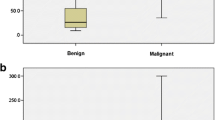Abstract
Objective
To investigate factors related to false shear wave elastography (SWE) results for breast non-mass lesions (NMLs) detected by B-mode US.
Methods
This retrospective study enrolled 152 NMLs detected by B-mode US and later pathologically confirmed (79 malignant, 73 benign). All lesions underwent B-mode US and SWE. Quantitative (mean elasticity [E mean]) and qualitative (maximum stiffness colour) SWE parameters were assessed, and ‘E mean > 85.1 kPa’ or ‘stiff colour (green to red)’ determined malignancy. Final SWE results were matched to pathology results. Multivariate logistic regression analysis identified factors associated with false SWE results for diagnosis of breast NMLs.
Results
Associated calcifications (E mean: odds ratio [OR] = 7.60, P < 0.01; maximum stiffness colour: OR = 6.30, P = 0.02), in situ cancer compared to invasive cancer (maximum stiffness colour: OR = 5.29, P = 0.02), and lesion size (E mean: OR = 0.90, P < 0.01; maximum stiffness colour: OR = 0.91, P = 0.01) were significantly associated with false negative SWE results for malignant NMLs. Distance from the nipple (E mean: OR = 0.84, P = 0.03; maximum stiffness colour: OR = 0.93, P = 0.04) was significantly associated with false positive SWE results for benign NMLs.
Conclusions
Presence of associated calcifications, absence of the invasive component, and smaller lesion size for malignant NMLs and shorter distance from the nipple for benign NMLs are factors significantly associated with false SWE results.
Key points
• Calcification and size are associated with false negative SWE in malignant NMLs.
• In situ cancer is associated with false negative SWE in malignant NMLs.
• Distance from the nipple is associated with false positive SWE in benign NMLs.
• These factors need consideration when performing SWE on breast NMLs.



Similar content being viewed by others
Abbreviations
- E max :
-
Maximum elasticity
- E mean :
-
Mean elasticity
- NML:
-
Non-mass lesion
- OR:
-
Odds ratio
- SWE:
-
Shear wave elastography
- US:
-
Ultrasonography
- US-CNB:
-
US-guided core needle biopsy
- USE:
-
Ultrasonographic elastography
- US-VAB:
-
US-guided vacuum-assisted biopsy
References
Uematsu T (2012) Non-mass-like lesions on breast ultrasonography: a systematic review. Breast Cancer 19:295–301
Wang ZL, Li N, Li M, Wan WB (2015) Non-mass-like lesions on breast ultrasound: classification and correlation with histology. Radiol Med 120:905–910
D’Orsi CJ, Sickles EA, Mendelson EB, Morris EA et al (2013) ACR BI-RADS® Atlas Breast Imaging Reporting and Data System. American College of Radiology, Reston, VA
Berg WA, Cosgrove DO, Dore CJ et al (2012) Shear-wave elastography improves the specificity of breast US: the BE1 multinational study of 939 masses. Radiology 262:435–449
Choi JS, Han BK, Ko EY, Ko ES, Shin JH, Kim GR (2016) Additional diagnostic value of shear-wave elastography and color Doppler US for evaluation of breast non-mass lesions detected at B-mode US. Eur Radiol
Ko KH, Jung HK, Kim SJ, Kim H, Yoon JH (2014) Potential role of shear-wave ultrasound elastography for the differential diagnosis of breast non-mass lesions: preliminary report. Eur Radiol 24:305–311
Shin HJ, Kim HH, Kim SM, Kwon GY, Gong G, Cho OK (2008) Screening-detected and symptomatic ductal carcinoma in situ: differences in the sonographic and pathologic features. AJR Am J Roentgenol 190:516–525
Ko KH, Hsu HH, Yu JC et al (2015) Non-mass-like breast lesions at ultrasonography: feature analysis and BI-RADS assessment. Eur J Radiol 84:77–85
Balleyguier C, Ciolovan L, Ammari S et al (2013) Breast elastography: the technical process and its applications. Diagn Interv Imaging 94:503–513
Youk JH, Son EJ, Park AY, Kim JA (2014) Shear-wave elastography for breast masses: local shear wave speed (m/sec) versus Young modulus (kPa). Ultrasonography 33:34–39
Chang JM, Moon WK, Cho N et al (2011) Clinical application of shear wave elastography (SWE) in the diagnosis of benign and malignant breast diseases. Breast Cancer Res Treat 129:89–97
Lee S, Jung Y, Bae Y (2016) Clinical application of a color map pattern on shear-wave elastography for invasive breast cancer. Surg Oncol 25:44–48
Cosgrove DO, Berg WA, Dore CJ et al (2012) Shear wave elastography for breast masses is highly reproducible. Eur Radiol 22:1023–1032
Evans A, Whelehan P, Thomson K et al (2012) Differentiating benign from malignant solid breast masses: value of shear wave elastography according to lesion stiffness combined with greyscale ultrasound according to BI-RADS classification. Br J Cancer 107:224–229
Evans A, Whelehan P, Thomson K et al (2012) Invasive breast cancer: relationship between shear-wave elastographic findings and histologic prognostic factors. Radiology 263:673–677
Gweon HM, Youk JH, Son EJ, Kim JA (2013) Visually assessed colour overlay features in shear-wave elastography for breast masses: quantification and diagnostic performance. Eur Radiol 23:658–663
Lee SH, Chang JM, Kim WH et al (2014) Added value of shear-wave elastography for evaluation of breast masses detected with screening US imaging. Radiology 273:61–69
Yoon JH, Jung HK, Lee JT, Ko KH (2013) Shear-wave elastography in the diagnosis of solid breast masses: what leads to false-negative or false-positive results? Eur Radiol 23:2432–2440
Chang JM, Moon WK, Cho N, Kim SJ (2011) Breast mass evaluation: factors influencing the quality of US elastography. Radiology 259:59–64
Chang JM, Park IA, Lee SH et al (2013) Stiffness of tumours measured by shear-wave elastography correlated with subtypes of breast cancer. Eur Radiol 23:2450–2458
Vinnicombe SJ, Whelehan P, Thomson K et al (2014) What are the characteristics of breast cancers misclassified as benign by quantitative ultrasound shear wave elastography? Eur Radiol 24:921–926
Berg WA, Cosgrove DO, Dore CJ et al (2012) Appendix E1, shear-wave elastography improves the specificity of breast US: the BE1 multinational study of 939 masses. Radiology:1-9
Gregory A, Mehrmohammadi M, Denis M et al (2015) Effect of calcifications on breast ultrasound shear wave elastography: an investigational study. PLoS One 10, e0137898
Bae JS, Chang JM, Lee SH, Shin SU, Moon WK (2016) Prediction of invasive breast cancer using shear-wave elastography in patients with biopsy-confirmed ductal carcinoma in situ. Eur Radiol
Kim SJ, Ko KH, Jung HK, Kim H (2015) Shear wave elastography: is it a valuable additive method to conventional ultrasound for the diagnosis of small (</= 2 cm) breast cancer? Medicine (Baltimore) 94, e1540
Lee SH, Chang JM, Cho N et al (2014) Practice guideline for the performance of breast ultrasound elastography. Ultrasonography 33:3–10
Author information
Authors and Affiliations
Corresponding author
Ethics declarations
Guarantor
The scientific guarantor of this publication is Boo-Kyung Han.
Conflict of interest
The authors of this manuscript declare no relationships with any companies whose products or services may be related to the subject matter of the article.
Funding
The authors state that this work has not received any funding.
Statistics and biometry
No complex statistical methods were necessary for this paper.
Ethical approval
Institutional review board approval was obtained.
Informed consent
Written informed consent was waived by the institutional review board.
Study subjects or cohorts overlap
Any study subjects or cohorts have not been previously reported
Methodology
• retrospective
• diagnostic or prognostic study
• performed at one institution
Rights and permissions
About this article
Cite this article
Park, S.Y., Choi, J.S., Han, BK. et al. Shear wave elastography in the diagnosis of breast non-mass lesions: factors associated with false negative and false positive results. Eur Radiol 27, 3788–3798 (2017). https://doi.org/10.1007/s00330-017-4763-6
Received:
Revised:
Accepted:
Published:
Issue Date:
DOI: https://doi.org/10.1007/s00330-017-4763-6




